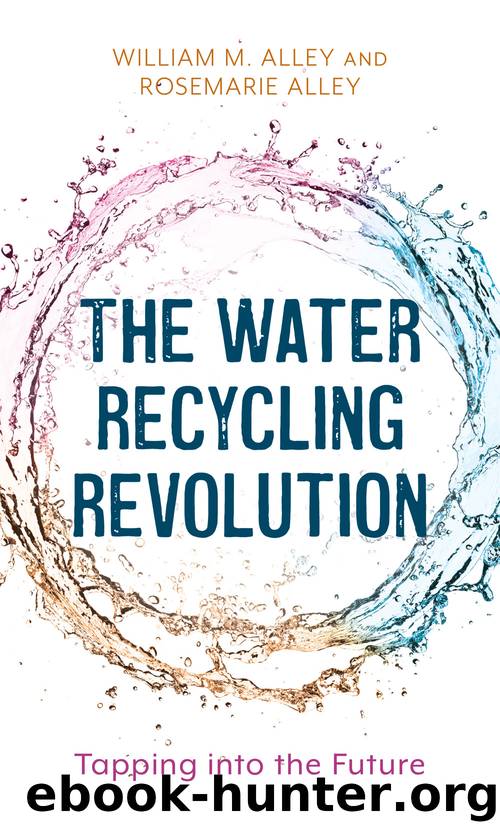The Water Recycling Revolution by William M. Alley;Rosemarie Alley; & Rosemarie Alley

Author:William M. Alley;Rosemarie Alley; & Rosemarie Alley
Language: eng
Format: epub
Publisher: Rowman & Littlefield Publishing
Published: 2022-03-04T00:00:00+00:00
SCOTTSDALE, ARIZONA
Scottsdale, Arizona, an affluent community and golfing mecca in the Greater Phoenix area, is home to Arizonaâs first advanced wastewater-treatment plant. This treatment facility relies on an unusual environmental barrier for indirect potable reuseâvadose zone wells (also known as dry wells). The story of this relatively unique approach to an environmental buffer, as well as Scottsdaleâs leadership in water reuse, begins with groundwater overdraft accompanying rapid population growth after World War II.
By the 1970s, groundwater depletion in south-central Arizona from Phoenix to Tucson was impossible to ignore. In many areas, ground-water levels had declined hundreds of feet, often accompanied by land subsidence and earth fissures. The need to aggressively manage the stateâs finite groundwater resources was obvious but controversial, particularly among the agricultural community. After years of debate, Arizona passed the landmark Groundwater Management Act in 1980.
The act created five Active Management Areas (AMAs) that cover much of the stateâs population and groundwater use, including a large area around Phoenix. The act required each AMA to develop plans to wean itself from overreliance on groundwater pumping. The Phoenix AMAâs goal is for annual groundwater withdrawals not to exceed the annual rate of aquifer replenishment by 2025âa condition referred to as âsafe yield.â20 In addition, new housing developments in AMAs must demonstrate an assured water supply lasting at least one hundred years, highlighting the need for renewable water supplies such as Colorado River water and treated wastewater.
Passage of the Groundwater Management Act was effectively a quid pro quo for receiving federal funding for the Central Arizona Project (CAP) to bring Colorado River water to Phoenix, Tucson, and other parts of south-central Arizona. The bottom line was that the federal government wasnât going to fund construction of the CAP without hard evidence that Arizona would get its groundwater pumping under control.21
The Groundwater Management Act and CAP provided strong incentives for water recycling and for storing water underground, actions in which Arizona had already begun to establish itself as a leader. Beginning in the mid-1960s, Herman Bouwer with the U.S. Department of Agriculture in Phoenix and Sol Resnick at the Arizona Water Resources Research Center in Tucson carried out pioneering work on soil-aquifer treatment.22 In 1972, the state issued some of the first rules governing reclaimed water in the nation. Today, more than 80 percent of all treated wastewater generated within the Phoenix AMA is beneficially used for various purposes or recharged.23 Among the more notable uses, the Palo Verde Nuclear Generating Station, the countryâs largest nuclear power plant, uses 100 percent reclaimed water for cooling.
With water available from the CAP, the state began an ambitious program to store its unused Colorado River allocation underground and went about developing a comprehensive regulatory framework for groundwater storage and recovery.24 Overdraft of the stateâs aquifers had provided plenty of space for underground storage.
Water conservation also became a high priority in the AMAs. Phoenix uses the same amount of water as it did twenty years ago, despite adding four hundred thousand more residents. âIn 2000,
Download
This site does not store any files on its server. We only index and link to content provided by other sites. Please contact the content providers to delete copyright contents if any and email us, we'll remove relevant links or contents immediately.
Whiskies Galore by Ian Buxton(41525)
Introduction to Aircraft Design (Cambridge Aerospace Series) by John P. Fielding(32885)
Small Unmanned Fixed-wing Aircraft Design by Andrew J. Keane Andras Sobester James P. Scanlan & András Sóbester & James P. Scanlan(32570)
Craft Beer for the Homebrewer by Michael Agnew(17930)
Turbulence by E. J. Noyes(7696)
The Complete Stick Figure Physics Tutorials by Allen Sarah(7135)
Kaplan MCAT General Chemistry Review by Kaplan(6592)
The Thirst by Nesbo Jo(6432)
Bad Blood by John Carreyrou(6271)
Modelling of Convective Heat and Mass Transfer in Rotating Flows by Igor V. Shevchuk(6219)
Learning SQL by Alan Beaulieu(6031)
Weapons of Math Destruction by Cathy O'Neil(5825)
Man-made Catastrophes and Risk Information Concealment by Dmitry Chernov & Didier Sornette(5644)
Digital Minimalism by Cal Newport;(5388)
Life 3.0: Being Human in the Age of Artificial Intelligence by Tegmark Max(5182)
iGen by Jean M. Twenge(5158)
Secrets of Antigravity Propulsion: Tesla, UFOs, and Classified Aerospace Technology by Ph.D. Paul A. Laviolette(4984)
Design of Trajectory Optimization Approach for Space Maneuver Vehicle Skip Entry Problems by Runqi Chai & Al Savvaris & Antonios Tsourdos & Senchun Chai(4837)
Electronic Devices & Circuits by Jacob Millman & Christos C. Halkias(4744)
